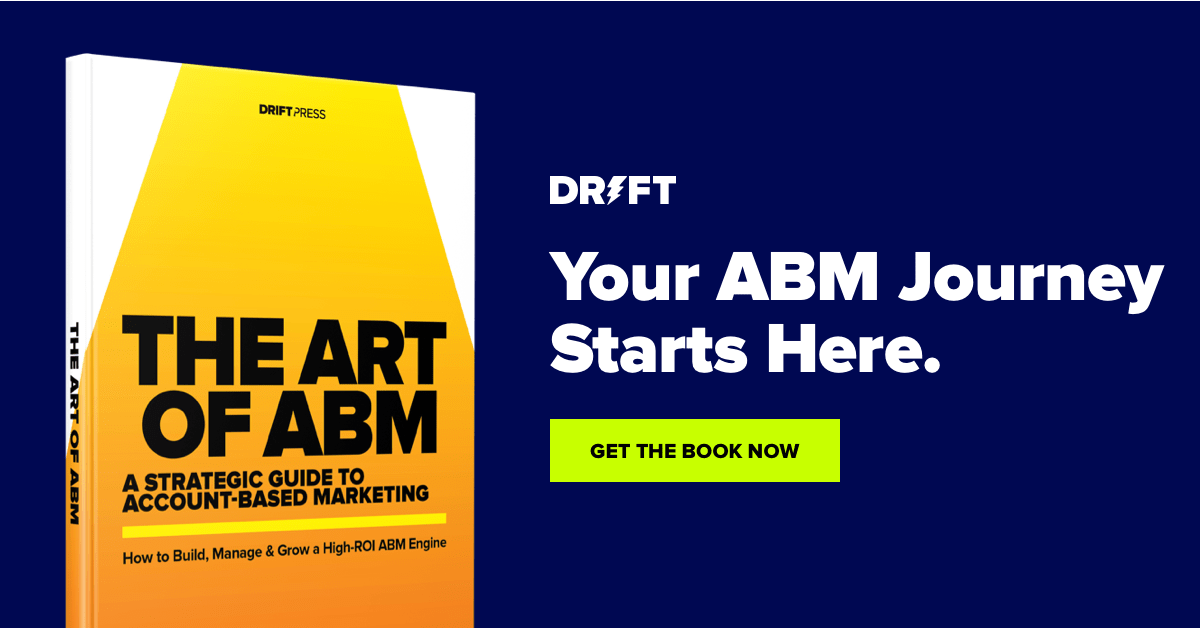If you’re a B2B marketer, you’ve probably had conversations (and I mean, a LOT of conversations) around the importance of having an account-based marketing (ABM) strategy. But you might not have spent as much time discussing how to actually implement an ABM program – to put it into operation and to measure it.
The secret? Your operations team probably already has the tools and skills to make it happen.
I’ve worked in demand generation and marketing operations for about 10 years and let me tell you, operationalizing your ABM program can feel daunting. But it’s crucial to set yourself up for success.
Without a clearly defined strategy and process, you may struggle to get the alignment and resources needed to execute your plan. And without a way to easily track and measure the results, you’ll be unable to communicate the success of your efforts – and unable to achieve your ABM program’s goals. That’s why I’m sharing with you my top strategies for launching and tracking a successful ABM program, how best to work with your sales and marketing team, and more.
I spoke about these strategies on a webinar with Content Marketing Institute. If you want to watch the recording, here’s the full presentation on How to Execute Your ABM Strategy and Operationalize Your ABM Program. Otherwise, keep reading for all the insights 💡
The Foundation of ABM = Personalization
We all know that personalized experiences are more effective. In fact, 80% of consumers are more likely to make a purchase when brands offer personalized experiences.

That’s exactly what ABM is for your business – personalization at scale.
So it’s no surprise that budgets are increasing by 40% when it comes to account-based marketing.
The good news? You can get results right away with an ABM strategy. Take Drift for example:

We tested the performance of our own ABM account list vs. a lookalike list of accounts and the results were off the charts 📈
- 2x the number of touches = increased engagement
- 122% increase in lead score = more quality engagements
- 2x the number of MQLs = more qualified leads
- 3x the number of scheduled conversations and 2x the number of conversations held = more pipeline
- 2x the number of opportunities and 3x the value of those opportunities = more LTV (Lifetime Value)
- 41% higher ASP = more revenue
We achieved these results in one quarter. I’ll walk through exactly how we operationalized our ABM strategy and how you can do the same to achieve your business goals.
How to Set Up Your ABM Program
The purpose of ABM is to drive specific engagement within specific accounts.
It’s all about driving quality opportunities within companies that fit your ideal customer profile. That doesn’t mean the volume side of your business goes away – just that you need to be able to run more general inbound programs side-by-side with more targeted ABM programs.
Your goal is to spend time focusing on the accounts with the highest potential to buy that will deliver the best outcomes – without sacrificing volume from traditional inbound.
Easy, right?
Enter: The Double Funnel
What you need to solve this is not one, but two strategies that run simultaneously together. It’s called the double funnel approach:
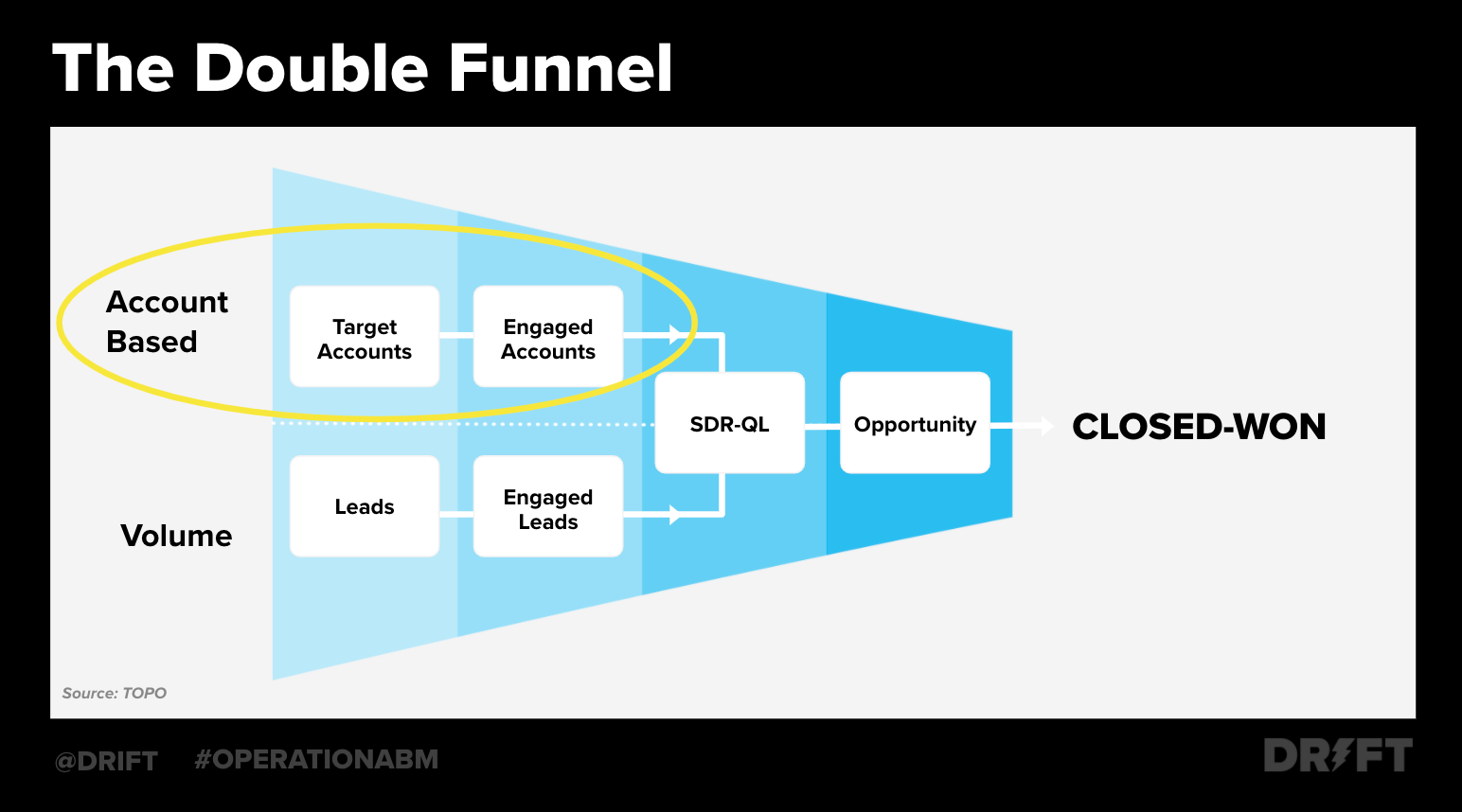
It splits your typical funnel into two branches – account-based and volume-based:
- The account-based funnel is made up of defined target accounts or ABM accounts. Typically, target account lists are selected because of firmographic traits or past behavior that suggest they’re a good fit for your product or service (and have a high propensity to buy). This is essentially a universe of all of the companies that you are trying to reach with your business. Your sales and marketing teams should prioritize these accounts through outbound efforts.
- Your volume funnel is everyone else. These are the people who are trying to reach you. (Worth noting: just because they’re a volume account doesn’t mean that they aren’t a fit for your product, it just means that you aren’t prioritizing them in outbound efforts.)
Operationally, setting up the double funnel means you need to take a step back and figure out your target accounts. How do you want to treat them in the system? How will you surface them to sales reps? How will you communicate the success of these accounts vs. your inbound ones?
You need to define success, first and foremost.
Otherwise, you’ll lose focus.
What ABM Looks Like
At Drift, we select a list of target accounts at the beginning of the year for all of our sales segments.
Our account-based funnel is made up of a larger list of about 10,000 target accounts across all of our core sales segments.
To do this, we create a model that takes those customer profiles and maps out everything about them, focusing on firmographic attributes that indicate whether or not an organization is a good fit. Things like:
- Company size
- Industry
- Engagement metrics
These indicators then form the focus of our integrated outbound campaigns with our target accounts (10,000). Everything we do in marketing is to reach those target accounts in some way.
Then, marketing and sales work hand in hand to narrow that down to a much smaller list of about 250 accounts (the “must close” accounts from that original list of 10k) that receive a white glove experience: the Drift 250.
In order to get to that 250 number, we sort the list based on the account firmographic score and select the highest ranked accounts. Next, we begin the most important part of our process – working with sales to hand-select the list. It’s critical to get sales buy-in and have them take an active role in the selection process itself.
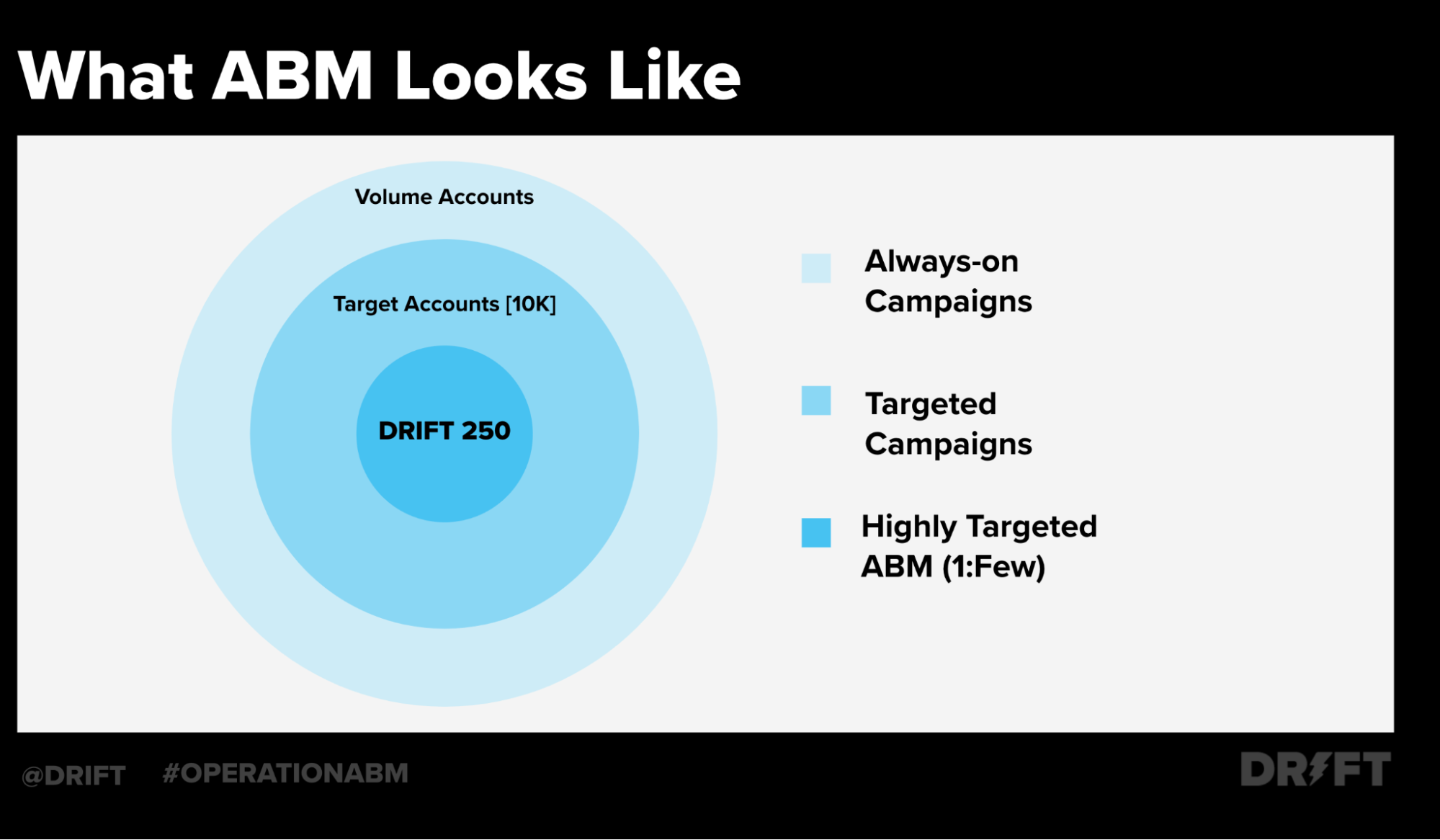
This list is never going to be perfect. But what it does is give you focus.
That doesn’t mean you neglect the volume accounts in that outer ring. Just because they’re not on your target list doesn’t mean that they aren’t valuable or that they won’t be a healthy customer. It’s just that you’re not actively using sales and marketing resources to solicit engagement from those accounts.
Let’s drill down one more level and talk through specific strategies to use once you’ve identified your ideal customers.
7 Strategies to Operationalize Your ABM Program
I want to bust one of the biggest ABM myths right here, right now.
Running an ABM program doesn’t mean you need brand new programs or all these special campaigns.
Okay. If you have true 1:1 ABM, there might be a few custom programs you have to build.
But in general, you’ll find most of these strategies look awfully familiar…the same marketing best practices you know and love, remixed to add more personalization.
Here are the seven core strategies we use to create different layers of customization within our marketing programs and operationalize ABM throughout the entire double funnel:
1. Create an ABM Center of Excellence
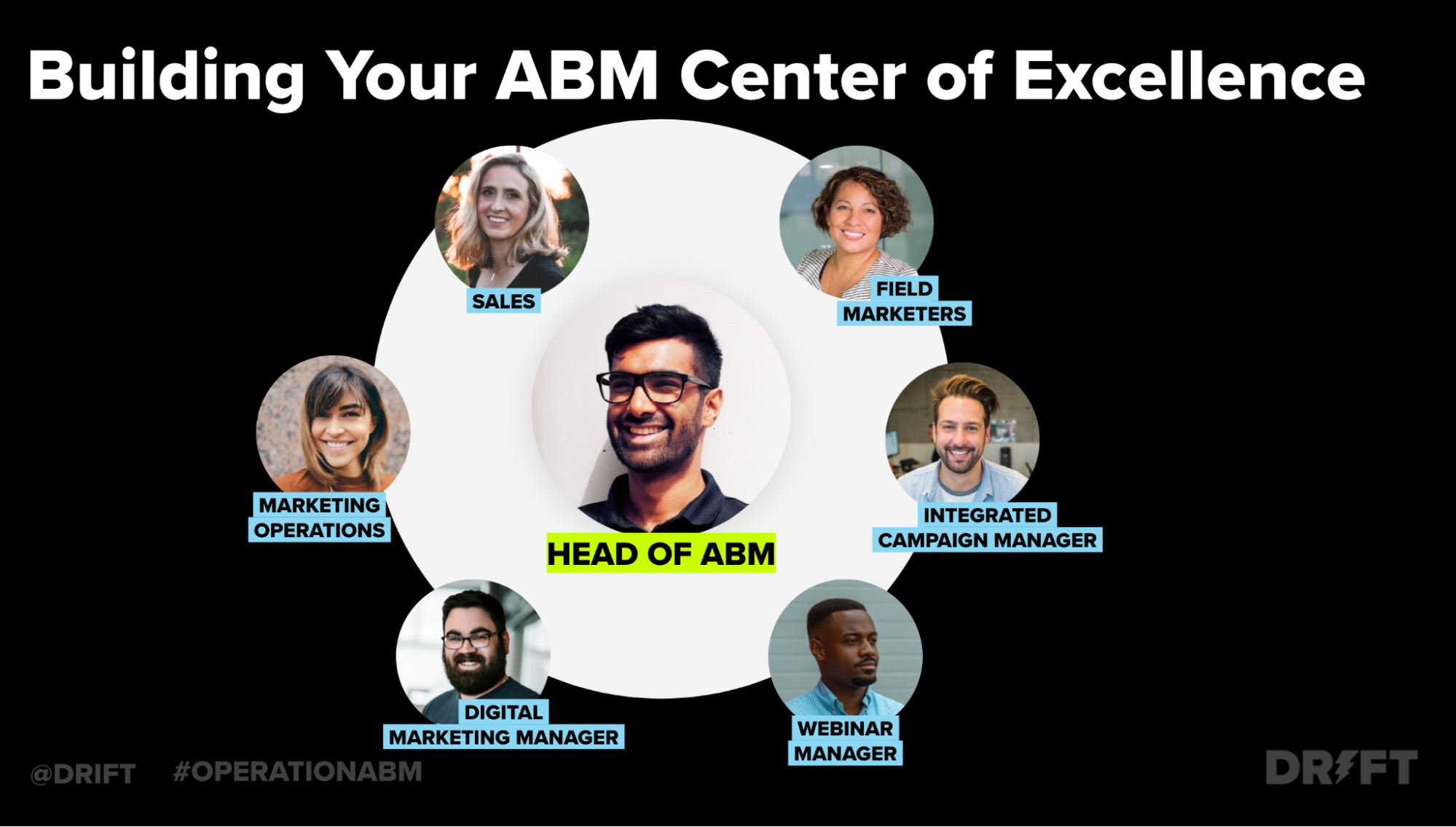
Executing a successful ABM strategy requires a lot of cross-collaboration.
Remember, you can lean on other people in your organization.
It takes an entire Center of Excellence for ABM to work. That includes:
- Sales: An obvious but crucial part of any ABM strategy. Without sales buy-in, ABM just won’t work.
- Field Marketers: Field marketers help package up global programs and adapt them to specific territories or specific business segments. They work to execute tactics in-region or in-segment and then also will execute things like regional events, dinners, etc.
- Integrated Campaign Managers: ABM is most successful when it’s a well-defined part of an integrated campaign plan. Your integrated campaign manager has a broad view of what’s happening in the quarter, and you can work closely with them to clone and customize those programs with personalization for your ABM audience.
- Webinar/Event/Content Managers: Stay tight with the people on your team who are responsible for creating content and events. You can piggyback on things they have in the works, like sponsoring a lunch during a planned event or offering a direct mailer to drive ABM account attendance to virtual webinars.
- Digital Marketing Managers: Your digital marketing team can help you create custom campaigns and experiences, particularly with digital advertising and email (we’ll talk about that in a minute.)
- Marketing Operations: (🤗 hi!) They’re the behind-the-scenes folks setting up lists, technology, tracking, and measuring success. Don’t forget to loop your operations folks in early in the process, because they can help make execution easier for you and your team.
2. Get the Right Tech Stack in Place
You likely have plenty of tools and technologies at your disposal to help execute these programs.
A successful ABM program does need a few tech investments, but the most important is an account scoring model.
It’s the key to building your list and narrowing your team’s focus. Without the information about what makes a good target account, you’re going to end up being too broad in your segmentation and you want to make sure that you don’t try to throw everything in with the kitchen sink.
You really want to select those accounts that you think are going to make the most impact.
There are ABM-specific platforms like Demandbase, 6sense, or Engagio, that can also help a lot with the reporting and building in some intent data and analytics. Here’s an example of everything you might need (some of which you should already have in your tech stack):
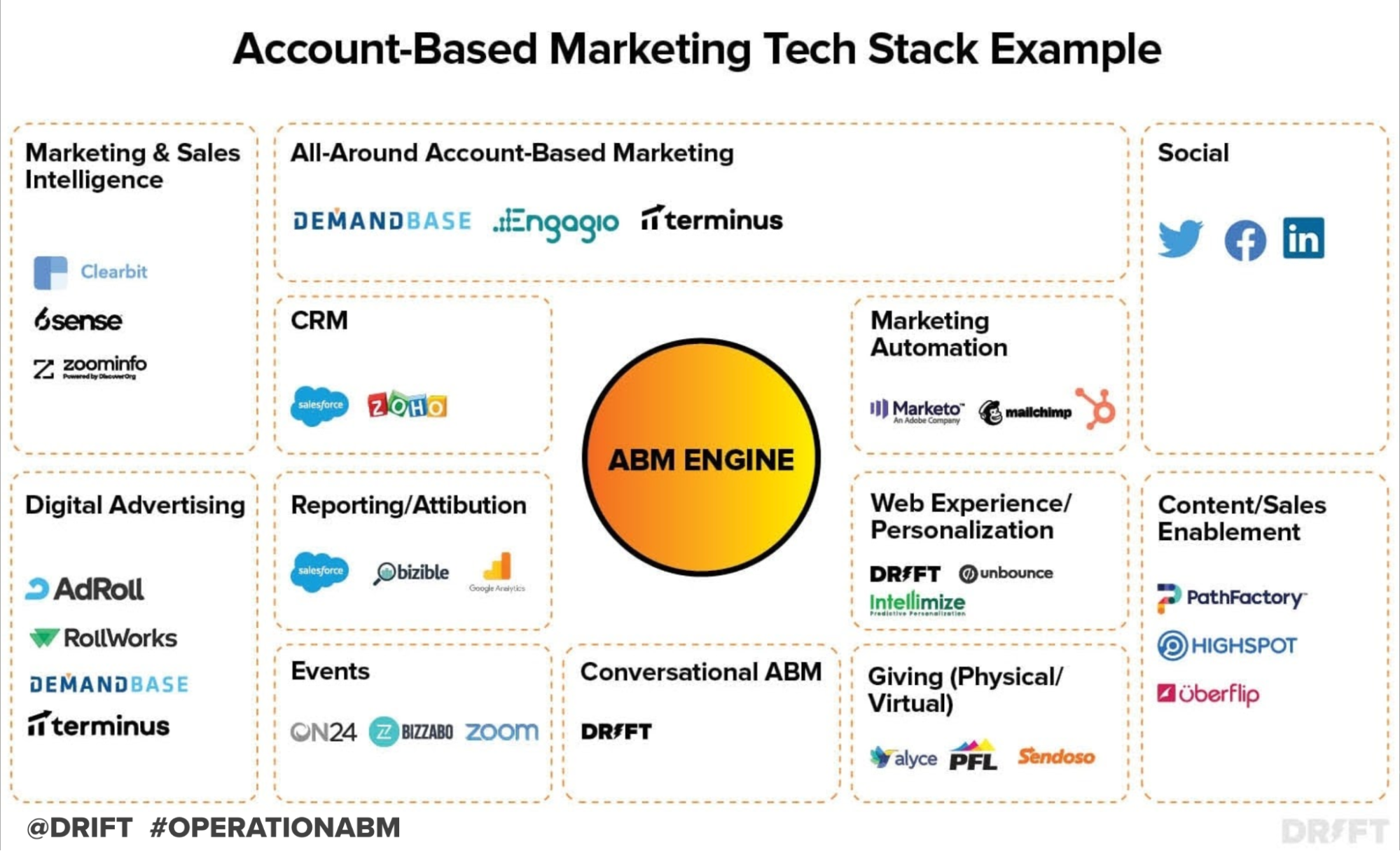
3. Align Sales and Marketing Teams with Shared Goals
This is the holy grail of any ABM strategy.
Without aligned teams, you won’t be able to make ABM happen.
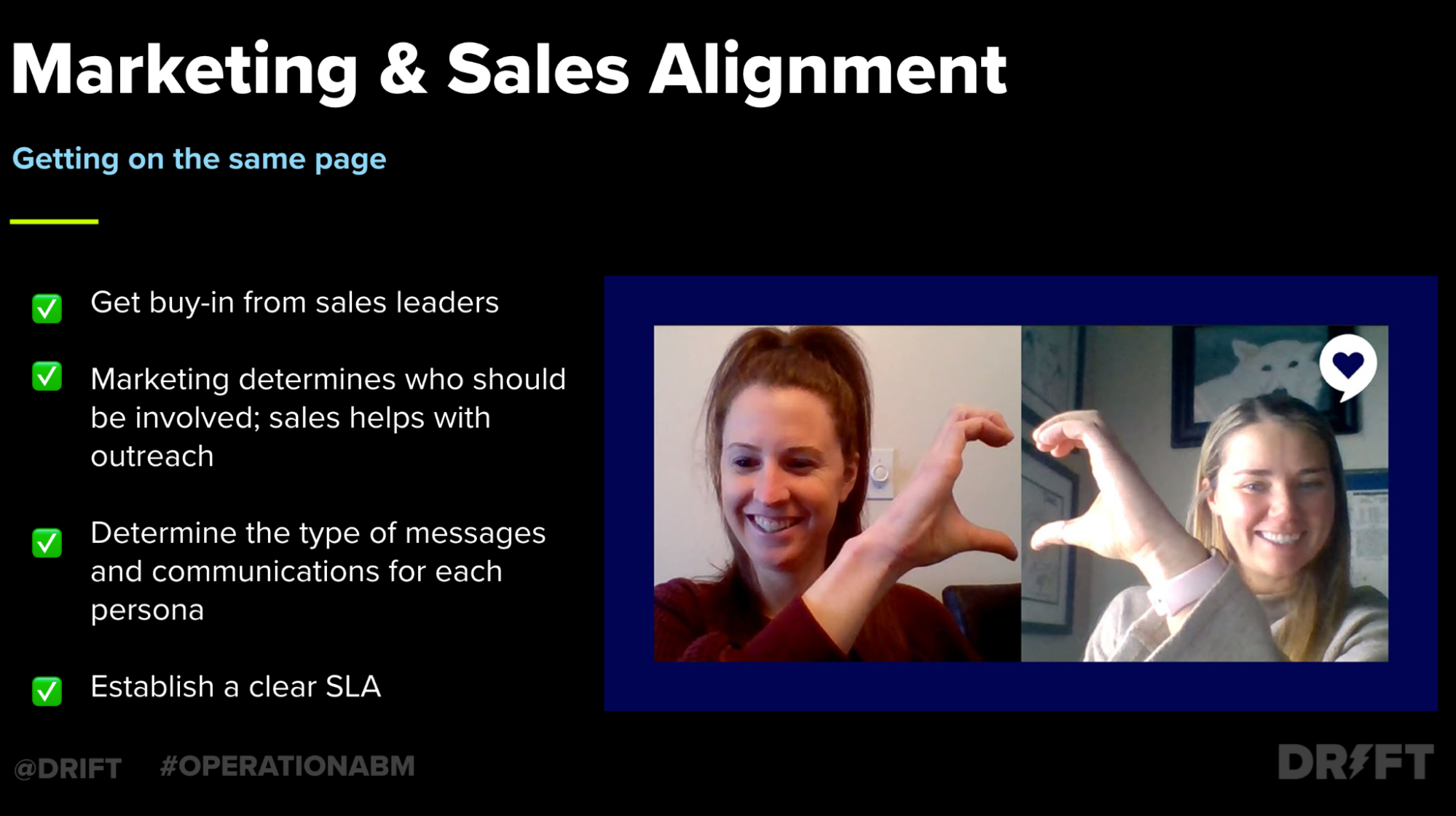
Our marketing team meets bi-weekly with the enterprise sales leaders to talk through metrics, upcoming activities, and stay in sync.
We revisit what’s working and what’s not, talk about our processes and how to make them better, and determine who should own which pieces of the puzzle. It’s our job in marketing to equip the sales team with as much insight as possible – like how specific accounts perform or behave, or any changes to our performance.
Ultimately, that gives the sales team a way to move forward. They can choose how many accounts to assign each rep, how many SDRs are on board, and what the next steps are. The responsibilities are truly shared so it doesn’t fall on one team or the other.
4. Build Your ABM List
Time to get those pens and pencils out. For the Type-A readers in the house, this is for you:
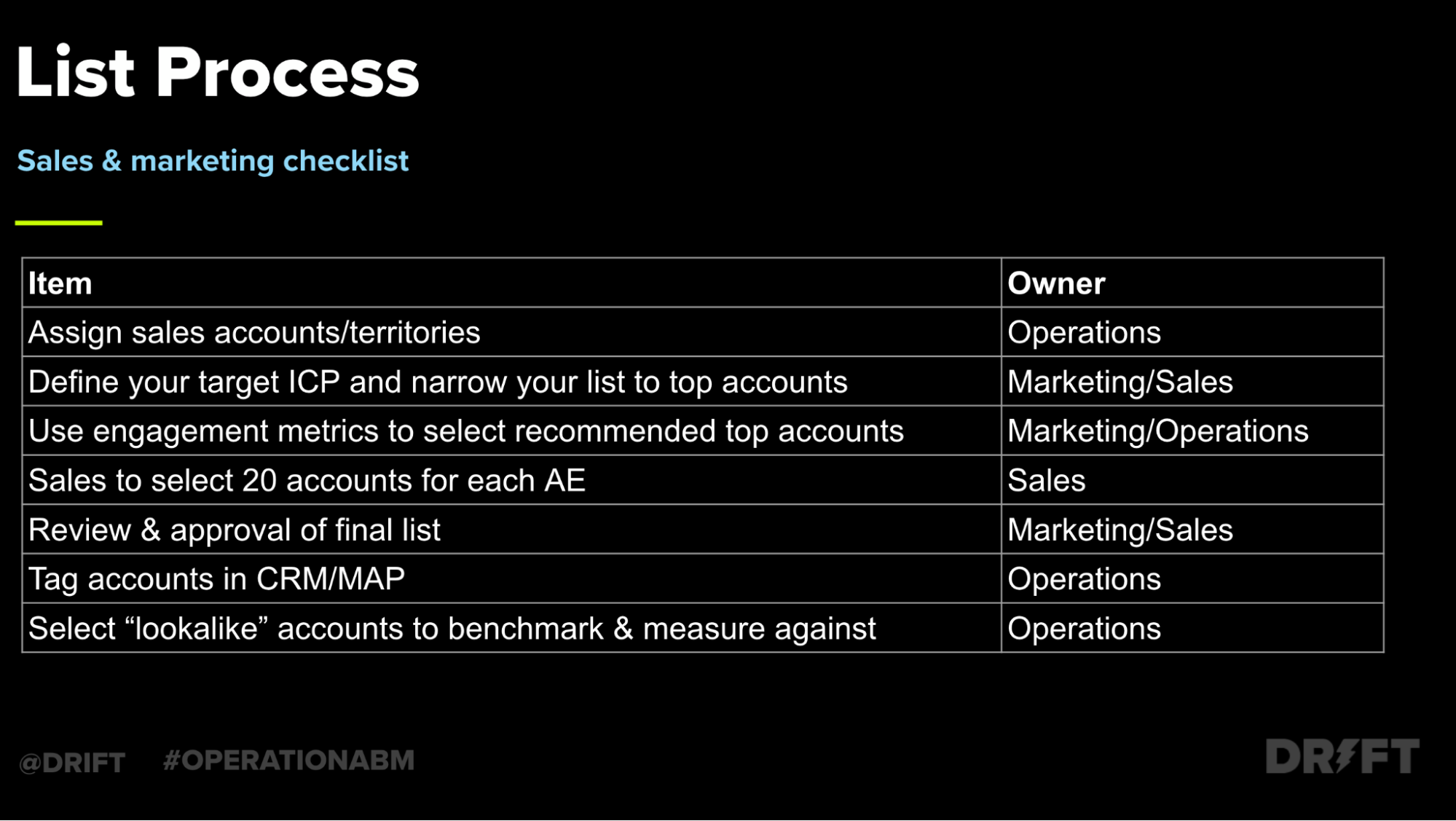
First: ownership. This checklist above shows you the typical owners and responsibilities for each part of the ABM process. That way it’s super clear who does what so you can set expectations upfront.
Then, we assign directly responsible individuals (DRIs) for each of these items. To build your list, you need to:
- Assign sales accounts or territories. This is probably already in place if you have an active sales team.
- As we discussed above, define the universe of your ideal accounts based on those firmographic attributes that indicate a good fit. This is your focus for outbound marketing and sales efforts throughout the year.
- Narrow that list further to select your top-tier ABM accounts (for us, the Drift 250). These get the ultimate white glove treatment from sales and marketing.
- Assign sales reps to a given number of those accounts. At Drift, we keep the ratio of about 15-20 accounts per person. Both teams (sales and marketing) must work off of the same list.
- Tag those accounts in your CRM or marketing automation platform. (I’ll deep dive into this next.)
- Select a list of similar lookalike accounts to benchmark and measure against. These may be firmographically similar to the Drift 250, but just didn’t make the list and don’t get the same personalized approach. By benchmarking results using this “lookalike” group, you can compare side-by-side and see which one is actually showing better results.
5. Tag Accounts in the System
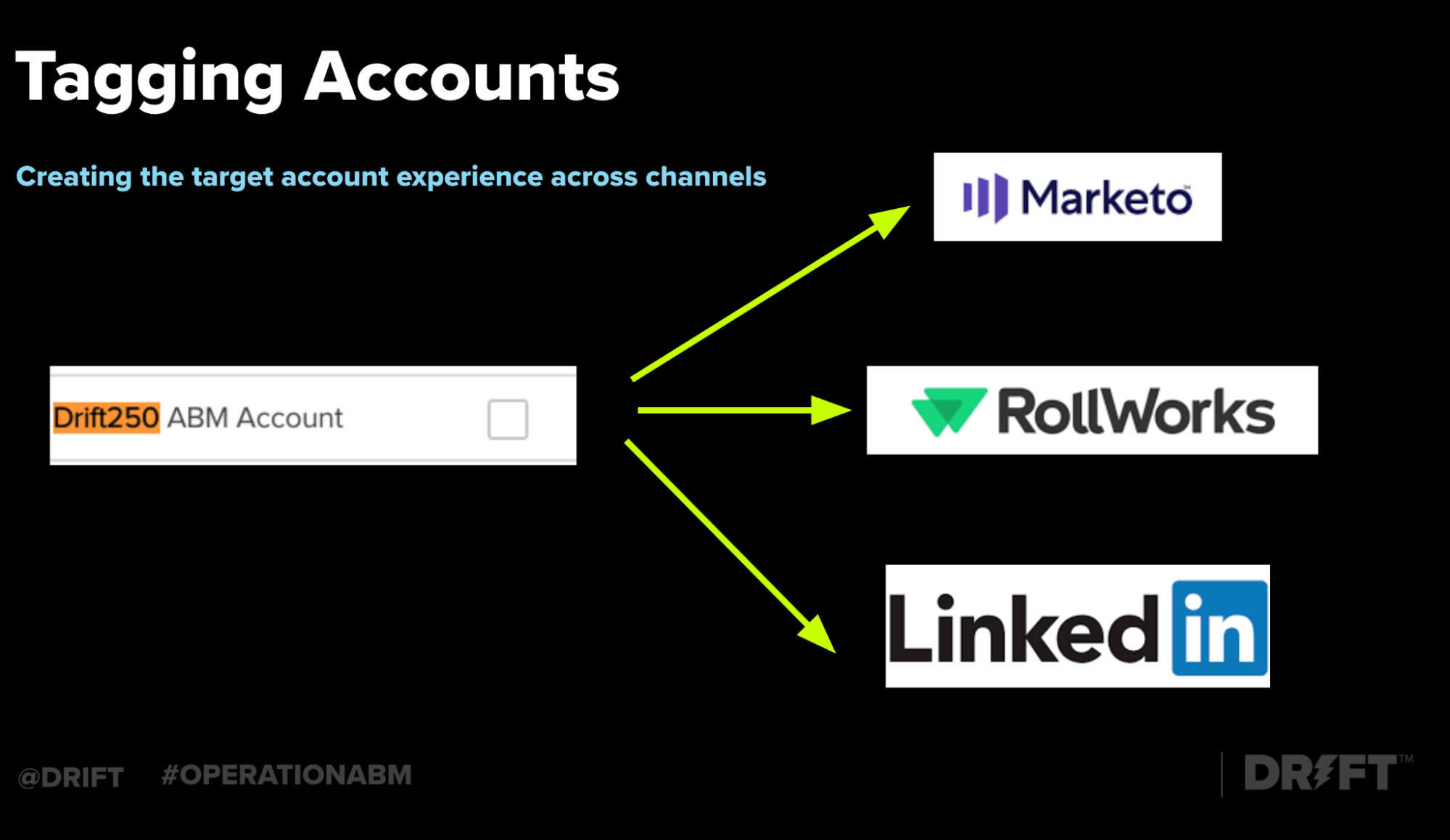
Once you’ve finalized the list, you can tackle identification and tagging within your systems. There are plenty of ways to do this, but the easiest way I’ve found is to create a custom checkbox and use it for your target accounts.
We also add a second field that stamps the date a given account was added to our target accounts list so we can track how quickly deals move to close.
That way, you can pull historical performance metrics for those specific accounts all the way down to closed/won. From there, we can use this tag to pull reports, send lists over to RollWorks for targeted display ads, or send specific email campaigns. Armed with this information, your options are endless.
6. Define Channels and Experiences
Now that you have the tools and the tracking set up, you’re ready to build out your ABM program.
With ABM, you have to take advantage of all the channels you have at your disposal.
Each individual element itself is important, but you need multiple offers and multiple touchpoints across various channels in order to be successful. Your goal is to broaden your reach and build out all of those core personas that you need to involve in a deal and get them to convert faster on your site. So it’s not enough to focus just on one channel or one type of activity.
Map out exactly how your top ABM accounts are going to experience your brand across your website when they come inbound across those paid channels like paid social or targeted display.
You need a unified strategy for outbound, too. Whether it’s sales outreach or display ads, you need to map out the entire process. It can take 10 or more touches across an entire account in order to convert it into an opportunity.
Set a benchmark by analyzing what this looks like for one of your healthiest accounts. How many people got involved in the sales cycle, what were the different personas that we’re looking at, and what are the best channels and tactics to reach those people?
Once you set a goal for your success, you can build out your plan using one of these templates:
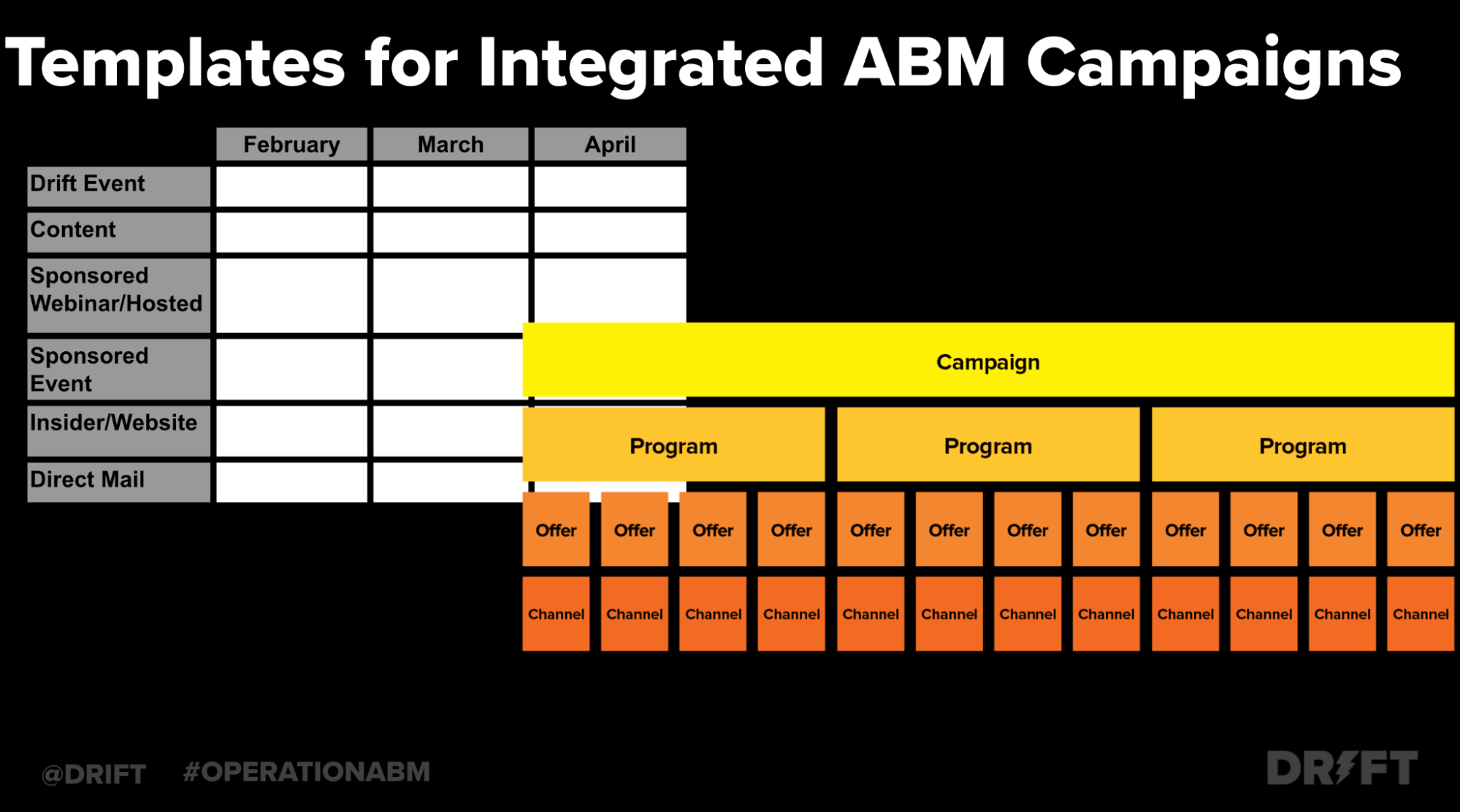
We run our integrated campaign planning quarterly, usually with 3-5 programs and then 3-4 offers (like a webinar or piece of content) per program.
We make one specific ABM offer for each program we run every quarter. (Remember layering? This is it.)
Keeping with our events example:
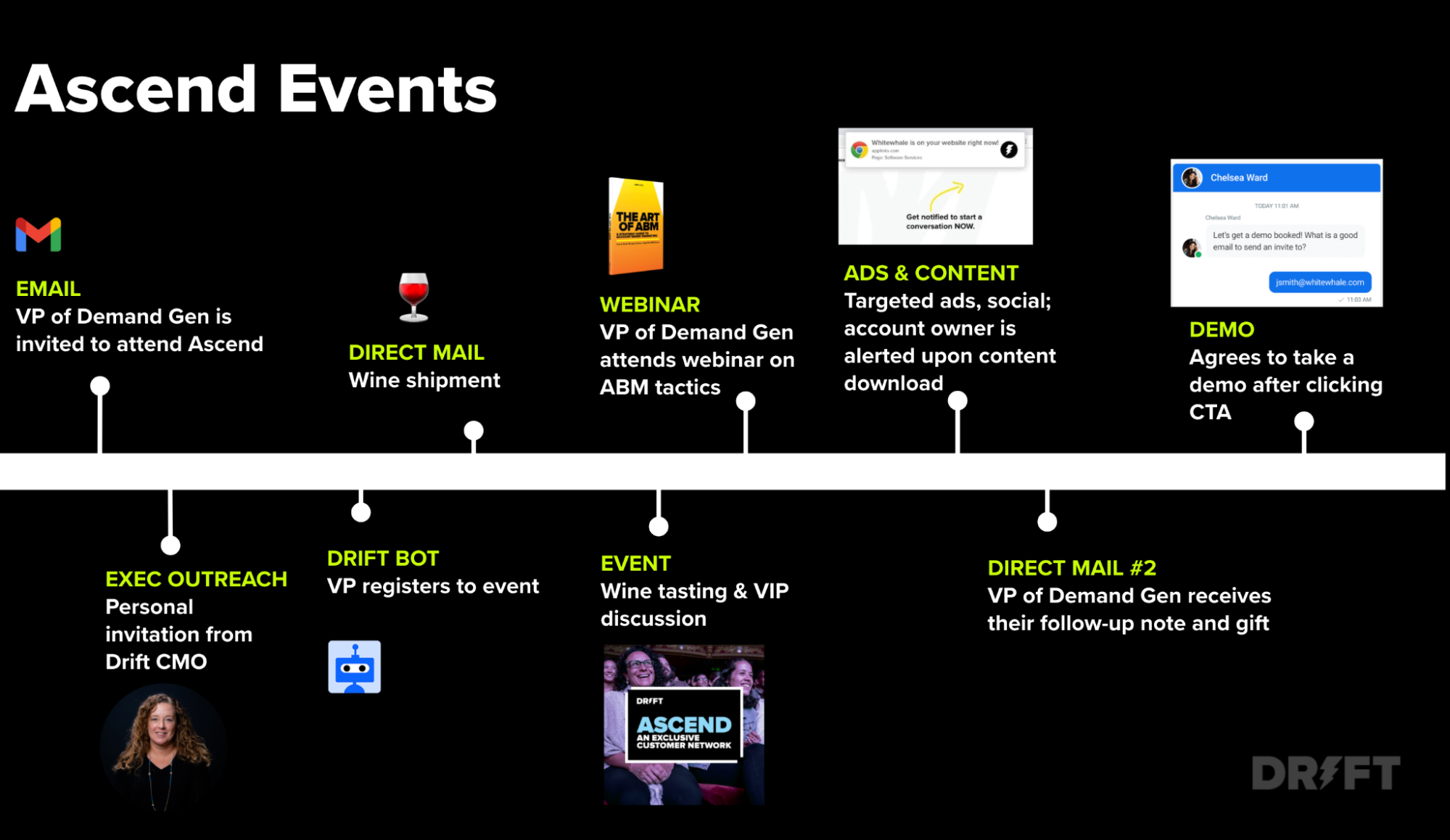
Drift’s Ascend events are VIP, exclusive experiences that target our ABM accounts. Throughout a six-week period, we send invites to special events, conduct personal outreach through LinkedIn or email, and coordinate with sales every step of the way so they know when to follow up.
Once the person registers for the event through a customized Driftbot, they come to a personalized landing page based on where they converted. So they’re welcomed again on our website with a really personalized touch. From there, they enter their address and they get a direct mail offer – for example, two bottles of wine to taste with us during a VIP virtual wine tasting.
After the event, we follow up by inviting them to another event, drive them back to our website for additional content, and send another piece of direct mail with an exclusive gift.
After that, we’re ready to roll out the red carpet for their final demo. It takes several steps and multiple channels weaved together, but it delivers a one-of-a-kind experience for those accounts that make them want to do business with us.
7. Measure Effectively
Now, you can’t prove the success of an ABM program without first having a goal behind it.
57% of companies haven’t been able to measure the effectiveness of their ABM programs.
Well, I’m here to fix that.
The first step is figuring out what your goals are.
Any program manager needs to define what success looks like upfront, and ABM is no different. Before you start anything, set those KPIs and get buy-in from all of your stakeholders. That way you don’t have to feel like you are playing catch up as you’re executing on these programs. You already have exactly what you’re driving towards. And then you can focus on planning the activities that are going to move the needle towards those goals.
To do that, you need to ask yourself: What is the outcome you’re trying to drive with these target accounts? Your goals might vary based on the outcome. If your ABM program is in the early stages, then you’re likely focusing on driving acquisition within your prospect accounts. Here’s a tip: use your benchmark data to inform where you set your sights. By analyzing similar accounts and how they perform, you can get an idea of what to expect from your ABM accounts without the additional touches of a personalized ABM campaign.
Other companies might be using a model where they are trying to reach target accounts for upsell opportunities or cross-sell opportunities. It’s still ABM. It’s just a different tactic and different outcome that you’re trying to drive. Here are the most common KPIs:
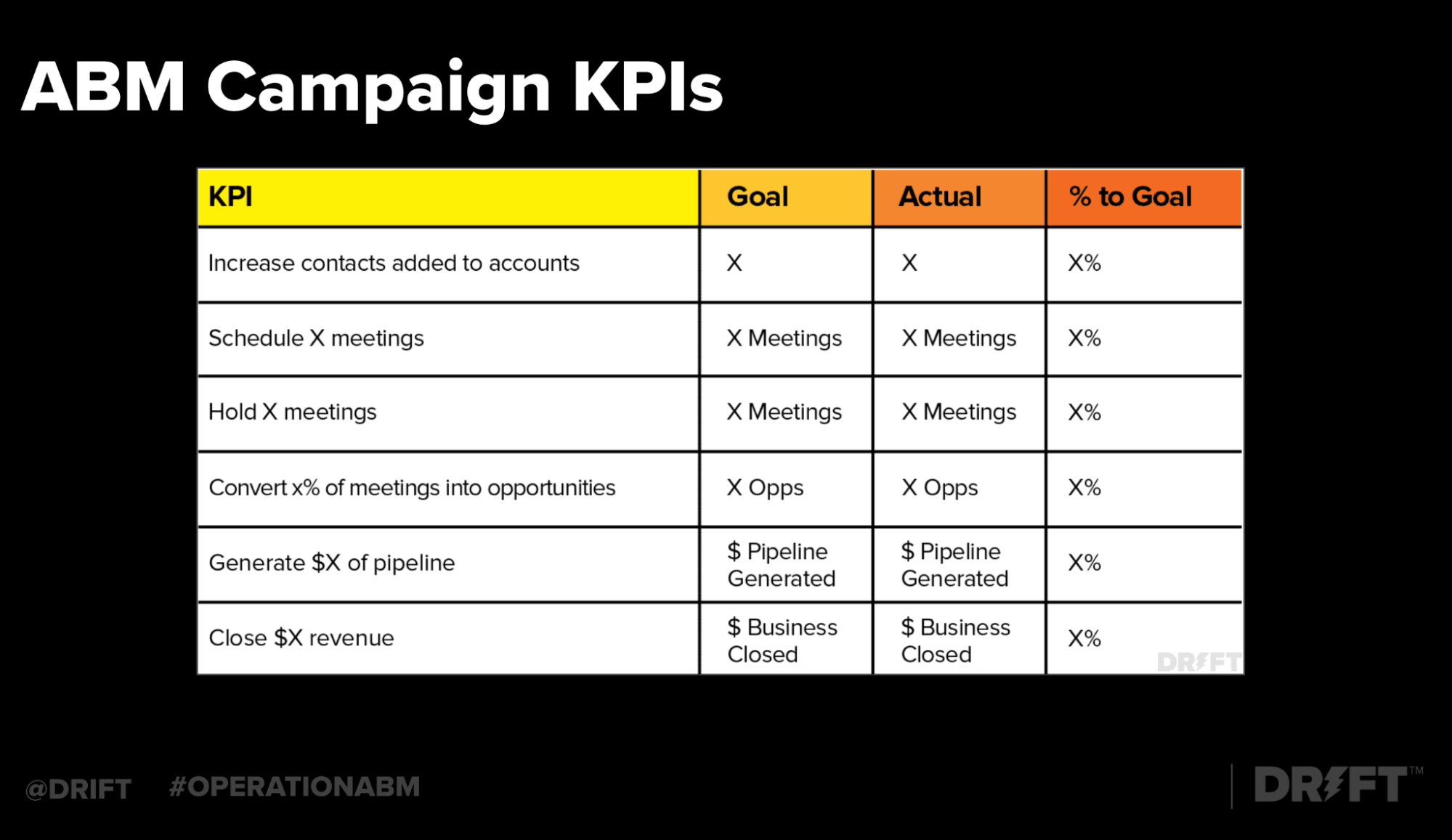
We set goals for each of our business units, as well as for each of our integrated programs and offers. We look at:
- Number of contacts added to accounts
- Meetings scheduled
- Meetings held
- Opportunities created
- Dollars in pipeline
- Dollars in closed revenue
Now, this is what that actually looks like in Salesforce:
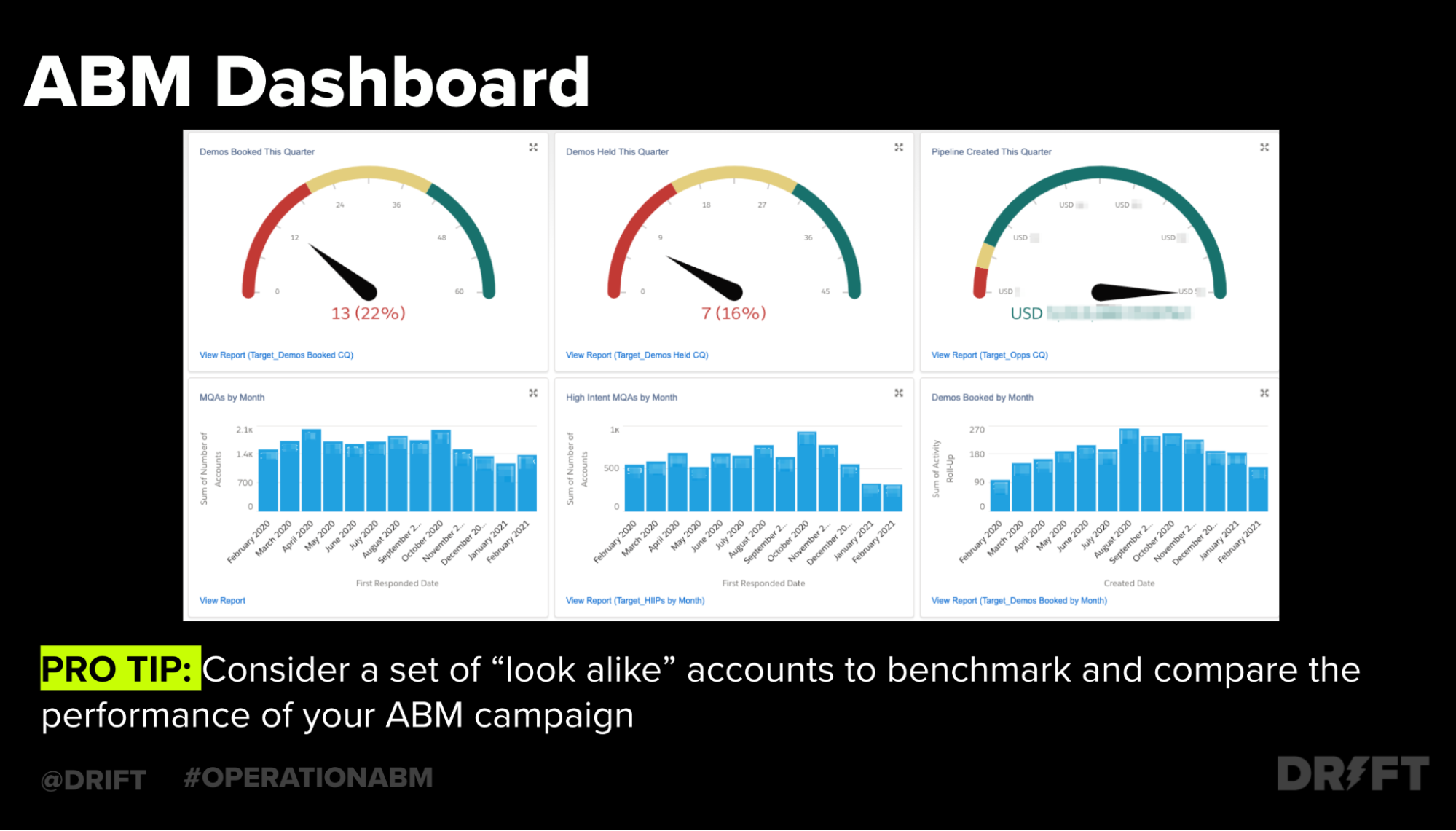
This surfaces our key engagement and opportunity metrics for our Drift 250 accounts and then measures exactly how effective we are at reaching those goals.
What this is is a one-stop-shop for measuring our entire ABM funnel. It helps us not only benchmark during the goal-setting process, but also gives us a really easy visual of how we’re doing month over month or quarter over quarter with these accounts.
Operations Is ABM’s Secret Weapon
As a marketing operations professional, I’m a little biased on this one.
But I’m here to tell you your ops team will be your best friend through this process, because they’re the ones who are going to help you streamline your account-based marketing process, integrate the right tools and technology, and make your life a lot easier when you try to reach new accounts with personalized experiences.
You likely already have tools at your disposal in your tech stack that can help you execute.
What you need now is to pull in the right resources on your team to help you set ABM up so you can systematically reach those accounts more consistently on a long-term basis.





